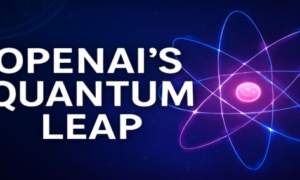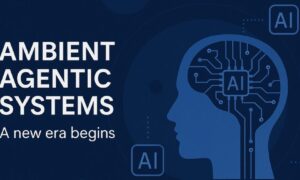Many employees lose interest in their work when repetitive activities adversely affect their psychological well-being. However, robots and artificial intelligence (AI) enable organizations to re-engage their employees for more creative responsibilities while automating mundane tasks. This post describes the present and the future of AI developments that reshape interactions between humans and machines.
Understanding Artificial Intelligence (AI)
Artificial intelligence copies abstract thought processes through algorithmic self-learning mechanisms and imparts computers with problem-solving abilities. Although the complexity of AI-powered technology services will change from one provider to another, their dynamic nature promises versatile industry applications.
Speech recognition and synthesis is one area where AI technologies require further research and development (R&D). Meanwhile, the ethics of content generators concerning intellectual property rights (IPRs) and consent collection from photographed people have significant nuances.
Nevertheless, the world is in a transition phase where AI developments inevitably unlock a new future, but individuals are not ready for the change. Still, the machines simulating human behaviors are here to stay. Therefore, learning about the potential of AI is essential.
What Are the Latest Developments in AI?
1| Autonomous Steering Needles to Navigate Lungs
Researchers at the University of North Carolina have developed a needle-like AI robot that can navigate through the lungs of a lung cancer patient. It does not damage vital blood vessels or block small airways.
Although its ability to retrieve samples needs more research, it implies that AI-powered equipment will allow healthcare professionals to provide more precise surgeries. Moreover, the needle robot adjusts its movements by considering the constant lung changes due to the patients’ inhaling and exhaling activities.
2| ChatGPT Chemistry Assistant for Accelerated Literature Review
Scientists must conduct thorough literature reviews to learn what others have already discovered and proved by designing and analyzing experimental processes. However, conventional methods of literature reviewing are time-consuming, highlighting the need for customized AI chatbot development services.
A paper in the American Chemical Society journal demonstrates how ChatGPT can help researchers reduce the time spent finding factors responsible for a phenomenon.
The accelerated literature review becomes possible because of the strategically crafted prompt submitted to ChatGPT and text mining techniques. Later, another AI model utilized the findings to predict a complex chemical compound’s crystallization results in distinct experimental scenarios.
3| Computer Vision in Rehabilitating the Limited Mobility Patients
Analyzing bodily strain in a patient suffering from limited mobility allows medical rehabilitation units to intervene in exercise-based treatment. They can address the movement issues by incorporating better exercise steps.
Scholars at the Pohang University of Science and Technology developed a computer-vision-based optical strain (CVOS) sensor. It visualizes how strain changes in multiple directions when the patient moves.
This invention is commercially more viable and durable, overcoming the key drawbacks of conventional sensors. It employs computer vision, an AI technology that allows machines to observe and understand physical events, like how we study the world through our eyesight.
4| Brain Implants and AI for Epilepsy Patients’ Speech Prediction
You can guess an individual’s thoughts if you can track brain signals. Radboud University and University Medical Center Utrecht have witnessed unique brain-machine interface developments powered by AI. Their researchers studied brain signals with artificial intelligence and implants.
Later, they employed AI-based speech synthesis technology to generate audible output for the decoded brain signals. Although the experiments made epilepsy patients focus on twelve words one at a time, further research will help them “speak” sentences, according to the researchers.
5| AI Unrelated to Humans but Inspired by Ecological Self-Regulation
The future of AI developments might have a fundamental framework independent of human cognition, creativity, and adaptability. Instead, by copying nature, artificial neural networks in computer vision and speech recognition will become more resilient to mode failure. Mode failure means AI models forget what they learned in the past when they get new training data.
Treating ecology as an individual, intelligent, and self-regulating entity requires a novel mindset among researchers. For instance, studying how an infectious disease might evolve into a global pandemic is challenging. That has virtually infinite variables that scientists cannot process. However, ecologists and AI developers can combine their skills to uncover insights that guide them.
Can AI developments that assume ecology as a single system test various diseases’ infectiousness without “forgetting”? Will ecology-based data ensure fewer data gaps since human-centric datasets recreate historical biases and injustices in the AI output?
These questions demand multi-stakeholder collaboration. Also, a paper in the National Academy of Sciences proceedings argues that ecologists and AI developers must help each other overcome obstacles in both fields.
Challenges of AI Developments
1| Privacy Concerns
AI can extensively gather user profile data from social networking sites, job boards, and news resources. While companies might have legitimate marketing interests in building consumer profiles, several organizations lack the implementations necessary to collect privacy consent.
More stakeholders demand transparency in how training data enables AI to estimate behaviors. They want to know whether personally identifiable information (PII) in the data might threaten an individual’s privacy. Therefore, professionals in AI technologies must effectively communicate the data usage purpose and cybersecurity strategy they will use for keeping training data safe.
A better approach to benefitting from AI developments can be avoiding PII risks by excluding or codifying data elements like names, addresses, contact details, and ethnic attributes. However, failing to do so can result in undesirable legal consequences.
2| Black Box Engineering and Injustice Risks
Black box AI developments can mislead the users due to skewed or misinterpreted output. Besides, the complicated process in AI operations makes it difficult for engineers to identify error factors and explain why specific AI results support controversial ideas.
Blindingly trusting an AI tool might revive stereotypical thinking. For instance, people from marginalized communities likely to spend time imprisoned due to authorities’ discriminatory attitudes might be untrustworthy to an AI tool. After all, AI cannot grasp the nuances and human-made historical data problems unless it gets trained to do so.
A poorly trained AI model can consider women’s skills inferior to men’s based on historical contribution data. This model cannot imagine how many societies violently prevented women from pursuing professional ambitions in tech, medicine, mining, defense, leadership, and literature.
If a policymaker or human resource manager utilizes similarly flawed AI developments, an employee might lose the paycheck, the family, and the reputation. Therefore, black-box AI leads to injustice and alienates the stakeholders it is supposed to serve.
3| Talent Shortage and Negative Perception
Responsible AI developments are impossible if academic environments, corporate training programs, and media coverage fail to inspire the next generation. Youth must fall in love with AI ethics, IT skills, statistics, and advanced mathematics. Otherwise, the current talent crisis will hinder AI projects that might overcome complex challenges.
Safe, friendly, and reliable AI models are hard-won results of professionalism, multidisciplinary team coordination, and mathematical expertise. However, if young minds feel AI threatens career opportunities instead of increasing them, they will voluntarily avoid and oppose it.
Addressing the talent crisis in the artificial intelligence industry and combating misinformation about AI developments will rely on stakeholder education. For instance, math instruction materials can become more impactful by leveraging gamification and teaching complex statistical tools with project-based learning.
After all, students and trainee recruits will be more enthusiastic about problem definition models if they can link them to real-world use cases. Likewise, launching public awareness campaigns guiding people on the safety and anti-controversy precautions in AI projects will help reduce the negative perception issues.
Conclusion
AI technologies can assist surgeons in navigating a patient’s body. Besides, they contribute to computer vision, language processing, and speech synthesis. These applications promise a bright future for persons with disabilities (PWDs).
The latest breakthrough in AI and analytics research might shift their focus from human-based abilities to natural cycles. Doing so can enable artificial intelligence programs to combat mode failure and increase their processing prowess.
However, AI developments have upset some stakeholders, attracting non-constructive criticism from civil groups, traditional institutions, and ill-informed individuals. Understandably, the fears of mindlessly applying AI in administration or sensitive procedures are well-justified due to artificial intelligence’s limitations.
Still, abandoning this incredible tech innovation can reduce a country’s growth potential because local industries will miss the competitive advantages of good AI tools.
So, stakeholders must invest in educating the next generation to develop more inclusive and dependable AI models. Increasing public awareness about AI ethics is also urgent. Meanwhile, leaders must devise regulatory norms to prevent irresponsible AI usage. These measures will create a peaceful future where everyone will witness how AI developments extend human capabilities and increase living standards.


































